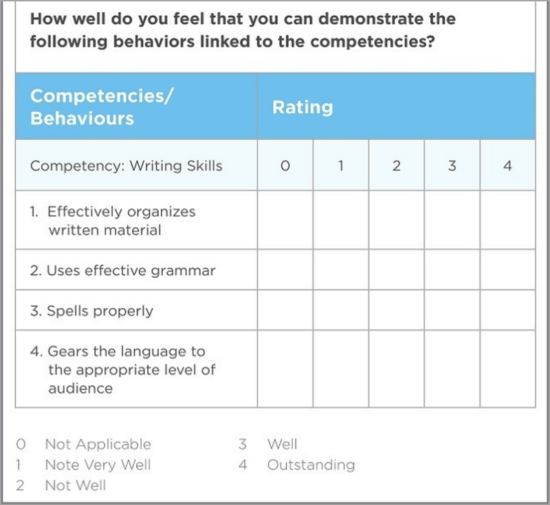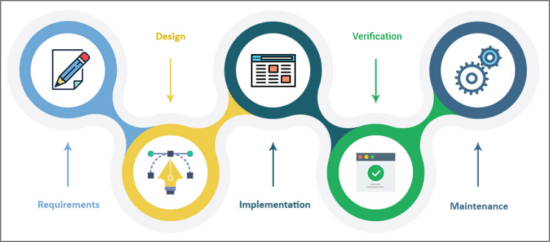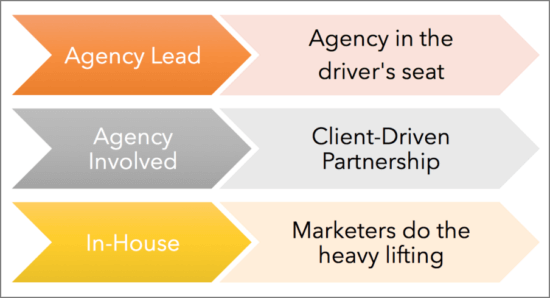As a small business owner, you can’t do it all. The first step is admitting you need help. The second is deciding how/when you could benefit from collaborating.
Before jumping to conclusions, you should first determine if your particular project is suitable for outsourcing. Assess your team’s competencies and define your marketing production workflow. Only then can you make the best decision for each of your projects.
Your team doesn’t have to do it all
After prioritizing your projects (however your organization does that), it’s time to decide whether any of them are appropriate to be outsourced.
To help with this decision, consider these key questions:
- Is this project mission critical? Is the success of this project critical to the success of our organization (to our vision and KPIs)?
- Is this project strategic? Does this initiative/project involve things like the integration of new marketing technology, or a revamp of our customer experience?
- Is learning important for this project? Is it important that your team get direct learnings from this project (rather than just ‘reported’ learnings from someone else)?
If you answered ‘Yes’ to two or more of these questions, you should probably insource this effort (do it internally). Otherwise, your project may be ‘outsource-able.’ But first, you’ll need to consider a few more things.
Download our Business Resource – Big book of marketing KPI benchmarks
Digital marketing enables managers to measure their activities more closely than ever before. Your marketing can become more data-driven and your analytics more actionable. By selecting and measuring specific KPIs towards your goals, you can achieve success in business
Access the Big book of marketing KPI benchmarks
Consider your team’s skills and availability
Begin with an honest assessment of your internal team’s capabilities, both in terms of skills (competencies) and availability.
Let’s say, for example, you’re launching an SEO project to move your blog post articles higher up on search results pages. You first need to consider your team's expertise and availability.
- If your best SEO analyst's time is already 95% allocated to another high-priority project, they either won’t give your project enough attention, or timely attention.
- Have another SEO analyst in the team but not sure if they have advanced-enough skills? Ask them to take an assessment. If they are less busy and have sufficient skills needed, they'll likely be a much better fit for your project.
As a manager, it is helpful to continue to assess your team's skillsets more broadly.

Assess if you have project leader types
Just as importantly, consider if your team possesses the right leadership skills. Make a list of people on your team who a) are great at keeping projects on track (Project Manager types, or PMs) and b) work well with clients (Account Manager types, or AMs). Maybe you have people that can wear both PM and AM hats.
If you have these types, and they’re not currently overloaded, you may be able to insource your project. If you don’t, lean towards outsourcing.
Keep in mind that, even if you outsource, you’ll need someone to serve as the ‘communication bridge’ between your internal team and the outsourced team. So you may get more leverage by assigning some of your AMs and PMs to outsourced projects.
Document your production workflows
As soon as you even consider the possibility of outsourcing work, you need to think about marketing production workflows. Why? Because you probably won’t outsource 100% of your work, just a portion of it. So you’ll need to understand how the outsourced tasks fit within your ‘master’ workflow.
To define your workflow, follow these steps:
- Discuss, define and document your current process
- Identify the issues with your current process
- Redesign your production process, as necessary (making sure it meets both your and your customers’ needs)
- ‘Beta test’ the new workflow with a couple projects
- Refine and finalize the workflow
Not about to clearly define your workflow, at least at this time? Take that as a sign you’re not yet ready to outsource. Instead, invest some time doing some ‘internal workflow house cleaning.’

A couple of CRO agency examples
I partner with a few conversion rate optimization (CRO) agencies as their ‘customer insights’ consultant. These agencies are CRO professionals; they use well-defined CRO processes, with well-specified analysis, and test ideation and test execution workflows. Here’s how their unique outsourcing models compare.
‘CK CRO Agency’: insourced customer insights
CK CRO Agency has an uber-well-defined CRO process. Since they operate in a region of Australia where staff costs are relatively low, and they want to keep their ‘core’ work in-house, they’ve decided to do all of their own:
- Web analytics analysis
- User experience (UX) research
- Test hypothesis formulation
- UX design creative
- Split test design
- Split test development and QA
They do, however, have some Freelance CRO Strategists in their staffing mix. These people, who typically work remotely, analyze the various data gathered by the researchers, then synthesize it into ‘key customer insights’ and ‘hypothesis ideas’ deliverables. These deliverables then get handed off to their creative and testing teams.
This hybrid insource/outsource model obviously requires well-synched coordination. But they accomplish this, with few production issues, due to their clearly-defined workflows and communication channels.
‘GH CRO Agency’: outsourced customer insights
GH CRO Agency, on the other hand, doesn’t know much about customer research, but they’re great at analytics and CRO plan execution. So they rely on me to:
- Plan and execute their UX research
- Come up with hypotheses and test plan ideas
- Produce the user experience (UX) creative
We then ‘collaborate at a distance’ as we work on projects. They wear the AM hat. I always wear the Lead Analyst hat. Depending on the project, I sometimes also wear the PM hat.
As long as the lines of communication and production workflows are clear, everything runs smoothly (well, most of the time; we are, after all, talking about creative digital marketing!).

Make your insource/outsource decision
At this point, if you’ve decided that:
- Your project is ‘outsource-able’ from a strategic perspective
- Your internal team doesn’t have the time or competency to do it (or do it well)
- You’ve got well-defined workflows
- it’s time to start outsourcing.
As I said in the ‘workflows’ section above, you first need to clearly define what tasks need to be done. Assuming you’ve done that, you need to specify the sub-tasks to be done. It’s all about being explicit about what you want so no execution details get missed.
True, your outsource vendor may find a better way to do what you’ve requested. If so, that’s great! You should discuss their ideas and modify your tasks, as needed. The key here: to stay synched with your vendor so you won’t have any unexpected execution issues.
‘Spec’ your tasks and sub-tasks
Coming from a user experience (UX) background, I’ve written a lot of specifications (specs) — specs for sites, specs for apps, specs for chat conversations, etc. And I know the importance of ensuring that specs are 100% clear when you’re ‘sending them over the wall’ to an outsourced team.
Here’s my recommendation: if you want to outsource, you need to have (or hire) a good ‘Spec’er,’ someone who specifies both a) the work to be done, and b) your expectations for the resulting deliverable. This person could be your UX Lead role, or even a PM. I’ve even seen a few Development Leads do this well. Regardless of who you choose, just make sure this person is a detail-oriented, written and verbal communicator.
Choose your outsource vendor
If you’re still on the ‘outsource this project’ path, it’s time to choose a suitable vendor. Fortunately, you now have more outsourcing options than ever before. The first thing you need to consider: whether the work you need done can be produced solely (or at least mostly) in isolation.
Maybe a freelancer will do
If you just need an ‘isolated’ deliverable, you can use a freelancer. By ‘isolated’ I mean work and deliverables that don’t need to be tightly integrated with your production workflow. Examples of this include:
- Brand logo and iconography design
- Website development
- Blog posts writing
- CRO (strategy and testing aspects)
These tasks are typically the realm of graphic designers, strategists, writers, and developers.
You may need a high-end agency
If you need UX support, you’re immediately not in the ‘isolated’ realm (though I’ve seen several companies make this mistake, by focusing just on the ‘UI Design’ aspect of UX).
If the work process you want to outsource is more complex, you should seek the support of a reputable digital marketing agency. I know, just saying the word ‘agency’ can prompt cost fears. As in, ‘If I work with an agency, I’ll have to pay $300 per hour because of their expertise and overhead.’ Or, ‘I might not get to work directly with the principal or a senior person.’ All valid concerns, for sure.
If, however, you’re working on a mission-critical project, it may pay off financially to work with a high-end agency to ensure a good outcome. (Remember return on investment, or ROI: sometimes getting a much higher return requires making only a modestly higher investment.)
Another key benefit of working with a higher-end agency: you’re most likely to work together as partners, which allows you to more tightly synchronize your work styles and workflows.
Finding a vendor is easier than ever
For most tactical projects, you just need a mid-level vendor, with proven results. These days you can readily find such cost-effective vendors by:
- Posting your work specs to Upwork.com or Freelancer.com. Keep in mind that, since many of these workers are overseas, you’ll be going beyond outsourcing to ‘offshoring'.
- Asking around your organization for recommended vendors in the functional areas you need (or for full-service outsource partners).
- Networking with your Linked contacts, or in LinkedIn Groups, to find agencies that are a good fit.
There’s no substitute for a personal recommendation, because these agencies have proven they can get the job done. It’s a balance: trading off expertise versus cost (and these costs can include the ‘execution risks’ you’re willing to bear).

You don’t need a crystal ball
You don’t need to rely on a crystal ball to decide whether to insource or outsource each of your digital marketing projects. By following these guidelines, you’re more likely to make the right decisions for both your tactical projects and strategic initiatives.
As side benefits, you’ll also see your work processes streamline and your client success metrics trend upwards.












